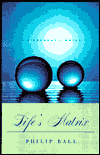Water: Awash in history
 We think we see right through water. It`s so common, so ubiquitous that surely there can be no mystery. Wherever we look, we see water. Two-thirds of the planet is covered with the stuff. It flows over our hands at the touch of a tap. It sloshes in rivers and lakes, and it covers the poles. It falls from the sky.
We think we see right through water. It`s so common, so ubiquitous that surely there can be no mystery. Wherever we look, we see water. Two-thirds of the planet is covered with the stuff. It flows over our hands at the touch of a tap. It sloshes in rivers and lakes, and it covers the poles. It falls from the sky. But like a person (also primarily composed of water), the most immediate, evident and familiar characteristics of H2O are only understood - if they are understood at all - by considering water`s deeper makeup, the hidden factors that shape its novel and unique behaviors.
Enter Philip Ball, an editor for the journal Nature, who has written "Life`s Matrix," a so-called biography of water. More than mere formal introduction to the subject, this is a tell-all, a saga awash in history, science and detail. It explains water down to the molecular level, though, in the end, the elemental question remains: What exactly is water? Certainly, no one knew in the beginning. Indeed, in the beginning, there seems to have just been water, nothing else.
Water forms the foundation of many, if not all, stories and ideas concerning the origins of life and humanity on Earth. In the Bible, the Hebrew God hovers over the waters. There is no sky, no dry land until God separates "the water under the expanse from the water above it" and commands that "the water under the sky be gathered to one place."
Similarly, water is central to the birthing myths in India, Russia, Asia and North America. In Polynesian cosmogony, a supreme being summoned Earth from the oceans. For Omaha Native Americans, all creatures floated disconsolately on an entirely submerged Earth until a great boulder rose from the deep. In similar fashion, Hindu and Mayan mythologies describe land concocted from all-encompassing water.
In truth, water wasn`t always "there." In the first millionth-billionth of a second after the Big Bang (the theoretical moment when the universe was born), it would have been too hot for water. Temperatures are estimated to have been about a billion billion degrees, too extreme for the existence of any matter as we currently know it.
But as the expanding universe quickly cooled, hydrogen formed, followed in time by the creation of oxygen. These two are the first and third most abundant elements in the universe; together - two atoms of hydrogen with one of oxygen - they famously form water.
Now there is water everywhere in space. The problem is that most of it isn`t usuable by life, which seems to insist upon the liquid form. (Hence the renewed excitement about possible life on Mars based on recent images showing crater erosion perhaps caused by liquid water.)
Whatever the story on Mars, water is the blood of the Earth. Without it, nothing survives. Humans, for example, are two-thirds water, most of it contained as cytoplasm inside each of our billions upon billions of cells. (Think of yourself as a vast assemblage of interconnected, microscopic baggies, each filled with water.)
But water works on much grander scales as well.
"Every day, every passing second, water is on the move," writes Ball. Rivers flow, oceans gyrate, clouds congeal and weep; over the course of three millennia, a volume of water equivalent to all of the oceans is recycled through the atmosphere. Yet, remarkably, at any moment less than one-thousandth of 1 percent of the planet`s total water resides in the atmosphere, just enough to deposit a single inch of rain throughout the world if it fell uniformly.
Such marvelous detail drips from Ball`s book. He includes a painstaking explanation of water`s tangled chemical history, albeit one that requires some rereading of technical passages. There are humorous illustrations of how water moves, constantly forming and reforming molecular bonds. Ball examines water`s inherent weirdness. Unique among liquids, it expands when frozen, which explains why ice floats. (Water is densest four degrees above freezing.)
Further, Ball offers a discourse on the nature of snowflakes and why they are always six-sided and flat. And the value of water to plants. Water not only is essential to biological functions, but also provides the internal pressures that help stems, stalks and leaves withstand wind, rain and children`s stomping feet.
Ball concludes with a short chapter on the state of the Earth`s liquid resources. Water may be everywhere, but it is not evenly so. In some places there is too much; in others, too little. More worrisome, humanity`s record of protecting this resource is poor. We have poisoned rivers and streams, killed entire seas. If water is the story of life, one wonders whether it will end tragically.
Don`t look for a quick, happy answer in Marq de Villiers` "Water." DeVilliers, a globe-trotting journalist, has spent much of his life indulging a fascination with water.
"In the thirty or so years I`ve been traveling about the globe for one journalistic purpose or another, I`ve been `collecting` water, whether as dams or rivers or lakes," he writes. "If time and projects permitted it, I would always allow myself to be diverted by water."
And so we read the fruits of de Villiers` floats down the Niger and Congo rivers on indigenous craft, watch with him as sturgeon die on the polluted Volga and laugh at frolicking dolphins in the Nile delta.
De Villiers describes the incomparable engineering of Hoover Dam, and its ecological consequences. And he poetically recounts crossing the Loire on the the very stones used by Richard the Lion-Hearted.
De Villiers` water travels are often meandering but sometimes wonderfully intimate. Like Ball, he dutifully notes the importance of water in early human mythology and suggests the first written laws may have been those governing the use of water in Mesopotamia.
He marvels at mankind`s earliest irrigation schemes (Roman aqueducts that ran for miles, transporting water solely through gravity) and creative distribution devices such as the central cistern system in Bruges (circa 1340), in which water was pumped by buckets on a chain underground to public faucets throughout the city.
Mostly, though, this is a cautionary tale, with doses of real alarm. If the world is truly getting warmer (de Villiers notes that scientists have yet to reach true consensus), then it is inevitable that a hotter Earth will affect the presence and quality of water.
But perhaps not nearly to the degree that people already have. A great, depressing chunk of this book describes what humans and their industry have done to water.
- A 1997 study by the Czech government found that three-quarters of all surface water in the country was severely polluted and almost one-third was so badly contaminated that it couldn`t support any fish at all.
- The Aral Sea, in what was formerly the Soviet Union and is now bounded by countries such as Turkmenistan and Kazakstan, has been irrevocably poisoned, its natural riverine water supply reduced to a trickle. The Aralis really an ex-sea now, a shrinking cesspool you can see from space.
- The Ogallala Aquifer lies deep beneath some 580,000 square kilometers of the American Great Plains, a vast underground reservoir containing trillions upon trillions of gallons of water. At the end of World War II, there were only a few thousand hectares of farmland irrigated with water drawn from the aquifer; by the 1980s, there were more than 7 million. More water is being drawn from the aquifer each year to satisfy farming and growing, thirsty cities than is seeping back down to recharge the system. Once, people thought the Ogallala would last forever. Current estimates suggest parts of it will run dry in 20 years.
Increasingly, water will be the stuff wars are fought over. When they finally resolve the politics of the Middle East, there will remain the question of who has water and who wants it. Likewise for most of Africa, parts of China and the American Southwest.
Such prospects are enough to leave the mouth dry with fear, but de Villiers is loath to leave the subject on such a forbidding note. He describes ingenious, if sometimes ill-fated, efforts to extract potable water from the sea, sky and polar ice caps.
The Earth recycles all of its water and so, it seems, must humans. Ideas such as recycling waste water (e.g. toilet to tap) may sound unappealing, but they are likely inevitable - because without sufficient water, the alternative is worse.
- Scott LaFee
(c) Copley News Service
advertisement

Author: Scott LaFee
Archives
Suzanne`s Diary for Nicholas
Hostage
The Final Season - Fathers, Sons and One Last Season in a Classic Ballpark
A Different Drummer
Glory Denied
The Cold Six Thousand
Poker: Bets, Bluffs and Bad Beats
A Primate`s Memoir
Every Handgun Is Aimed At You
Ball Four
The Adversary
They had the `fire` down below
They Were Ours: Gloucester County`s Loss in Vietnam
Morgan`s Run
Exploring the link between biology and behavior
More Articles







